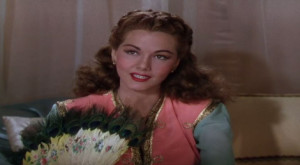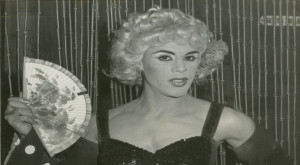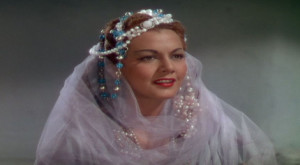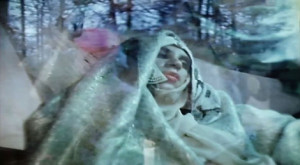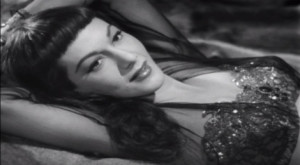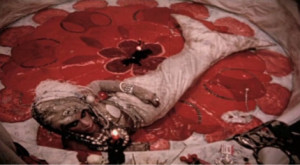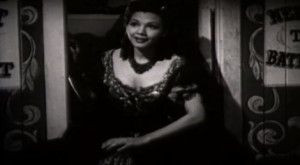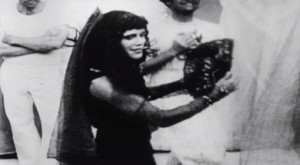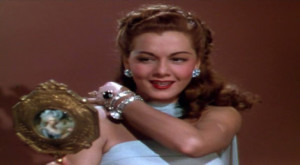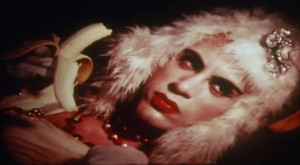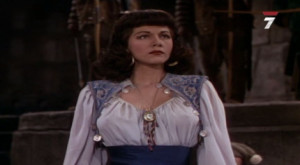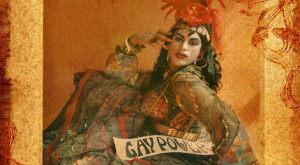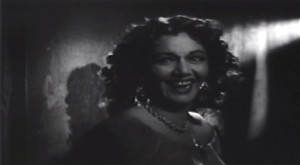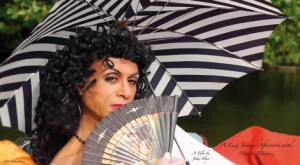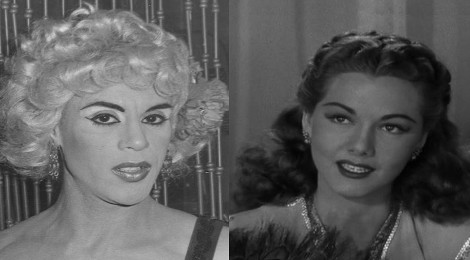
“I look Sexy-but Sweet”: Notes on Mario and Maria Montez
Mediático is delighted to present below an essay on Latina star of the 1940s Maria Montez, and Warhol superstar and drag pioneer Mario Montez by Roberto Ortiz, an independent scholar. He is working on a book on female stardom in classic Mexican cinema and another on Latino icons and camp stardom (Intellect) that will dedicate a chapter to Maria Montez.”
“I adopted my name from her. She does everything with such fire—nothing is pretended.”
–Mario Montez, 1967
“I am sick and tired of those [publicity] photographs. They make me look like a smoldering fire.”
–Maria Montez, 1944
I must have first come across the name of Mario Montez (1935-2013) sometime during grad school, but I didn’t really pay attention to his work until much later, following a casual conversation with a scholar who had written about him. He spoke admiringly of José Rodriguez-Soltero’s little-seen 1966 film Life, Death and Assumption of Lupe Velez and fondly of meeting its star, Mario Montez. When he described him, the adjective that stuck to my mind was “sweet,” a word that I did not associate with being a member of New York City’s queer underground arts scene in the 1960s.
I was reminded of that last year while reading film critic J. Hoberman’s obituary of Mario Montez :“Mario was a sweet, unassuming, modest man, and once he went into character, every inch a star” (2013). Hoberman’s words also brought to mind a 1944 profile describing Dominican movie star Maria Montez (1912-1951), after whom Mario took his stage name: “She is a junior Dietrich, a sultrier Lamour. She is the best example of how to become a movie star without knowing a thing about acting. Her explanation: ‘I look sexy—but sweet’” (Mason 1944).
Out of that brief description, I’d like to single out a few points of kinship between Mario and Maria Montez: the comparison to established, glamorous and exotic Hollywood stars, the notion of being “non-acting” stars, and the idea of looking “sexy—but sweet.” The first two attributes—together with their foreign origins—were among the chief reasons that most critics looked down on them. The third one was key to the ambiguous charisma that came through their films, photos and stills.
Very few would have doubted Maria Montez’s sexiness (she was a very popular WWII pin-up girl), but the image she conveyed was hardly one of “sweetness,” at least not in the sense of personality. And while those who have met him say that Mario Montez was a sweet person, his kind of “sexiness” would have most likely put off—or at least troubled—the fans of his namesake.
Born as René Rivera in Ponce, Puerto Rico, Mario Montez was considered the first drag “superstar” of Andy Warhol’s Factory, which he joined through artist and filmmaker Jack Smith (1932-1989). Rivera modeled repeatedly for Smith before making his screen debut as “The Spanish Lady” in Flaming Creatures (shot in 1962, released in 1963), where the director credited him as “Dolores Flores” after Spanish folkloric movie star Lola Flores, but also evoking Mexican Dolores Del Rio. According to Montez, Smith wanted to re-name him for his next film (the unfinished Normal Love, shot in 1963). He suggested taking the name of 1940s star Maria Montez, whom they both admired.
Mario Montez became an active member of New York’s experimental arts scene for the rest of the 1960s into the 1970s, but without indulging in its drug and alcohol-driven lifestyle. He was featured in numerous films by Andy Warhol and others, including Puerto Rican filmmaker José Rodríguez-Soltero and Brazilian visual artist Hélio Oiticica, who discussed Mario’s performance style in the 1971 essay “Mario Montez, tropicamp.” Montez was also a member of Charles Ludlam’s Ridiculous Theater Company, where he acted and designed costumes under the label “Montez Creations.”
Unlike most scholars, I didn’t find out more about Mario Montez due to my interest in 1960s US avant-garde cinema. I’d been researching the woman whose name he adopted. Given Jack Smith’s fixation and Mario’s adoption of her name, most of the little scholarly writing on Maria Montez is to be found within studies of experimental and/or queer cinema. However, most scholars who admire Jack Smith’s work clearly don’t share his fascination with Maria Montez and seldom look beyond basic (and often mistaken) facts about her. Their appraisal of her relies on Jack Smith’s appreciation in “The Perfect Filmic Appositeness of Maria Montez” (1962) and “The Memoirs of Maria Montez” (1963), essays that have more to do with Smith’s artistic beliefs than with the Dominican star.[1. Fellow underground artist and Montez devotee Ronald Tavel has written an instructive account of Jack Smith’s star worship of Maria Montez. Tavel (1997) notes that Smith wasn’t interested in what the Dominican star was like off-screen but in what she could inspire through her films and publicity stills: “In 1965 he told me he was fascinated by my study of her as a human being, because his study, he proclaimed, was purely visual” (95).]
For most critics, Maria Montez is an otherwise irrelevant B-level Hollywood starlet, marginal even within studies about Latinos in US cinema, where Carmen Miranda reigns as the Latino Stereotype Queen of Classic Hollywood Cinema. The Brazilian performer has become the subject of multiple (and often redundant) academic articles, dissertations, biographies and a recent book-length study in which Maria Montez is wrongly listed as one of Carmen Miranda’s B-level imitators (Shaw 2013). Within overviews of Latinos in US film, Montez is usually briefly discussed as a strikingly beautiful but vapid starlet whose main distinction is that Cobra Woman (1944) posthumously turned her into a gay camp icon.[2. As of this writing, the most thorough biography of Maria Montez, the lavishly illustrated María Montez, su vida by Margarita Vicens de Morales, is only available in Spanish (2003; “centenary edition” in 2012). Antonio Pérez Arnay’s María Montez, la reina del tecnicolor (1995), also vastly illustrated and in Spanish, is notable for the introductory essay by Catalonian writer Terenci Moix. Among the many brief overviews in English, there is a good encyclopedia entry by Frances Negrón-Muntaner (2006).]
In his obituary, J. Hoberman suggests that “Mario was more of a Judy Holliday type,” but the attributes that he proceeds to describe—good-natured and girlishly enthusiastic, gracious hauteur, illuminated the screen—could easily describe Maria, if one bothers to look beyond her screen roles. I’ll admit that, while learning more about Latinos in US cinema, I initially dismissed the brief career of Maria Montez. It took me some time to look through and beyond her glamorous exotic image, especially since I didn’t share the interest in her costumes and jewelry (“they’re the most colorful… gorgeous jewelry, the detail too”) that drew Jack Smith and Mario Montez to worship her.
At first, Mario and Maria Montez come across as imitations or, worse, imitations of imitations. What’s fascinating about them is that, upon closer inspection, they both turn out to be truly original. Despite bearing little physical resemblance, the adoption of Maria Montez’s name was more fitting than Jack Smith or René Rivera could’ve imagined. As a tribute to them, I share these brief observations about the late Puerto Rican artist and his Dominican muse.
* * *
1. The clichéd argument would be to say Maria Montez embodied the essence of drag performance (or, as Mario preferred to say, “going into costume”), that her attempts at embodying 1940s-style Hollywood glamour failed and that her failures (the bad acting, the B-level star status) revealed the constructed nature of gender and ethnicity. The still of Maria Montez featured in a recent book about Jack Smith seems to support that notion (Johnson 2012: 146). It’s a strangely unflattering photo of Montez dressed as Antinea, the vamp protagonist of Siren of Atlantis (1949), her last Hollywood film and Smith’s favorite. Her face is made-up and retouched so much (especially by the mouth and cheeks) that Maria does look like a drag queen. The costume also makes Montez (who reportedly tended to gain weight and died taking a weight-reducing bath) look heavier than usual and gives an unusual shape to her breasts (Maria infamously didn’t like wearing bras, evident in her photos and films).
Yet the actual film features some of Maria Montez’s most flattering close-ups and her most popular publicity stills (whose originals can bid surprisingly high on eBay) are those that highlight her glamorous beauty, not any drag queen lookalike poses. A facile equation to drag queen-ism as deconstruction exercise would miss that the images of Maria and Mario Montez had an opposite effect. In their way, they normalized the artifice that surrounded them, rather than expose it as such. Although she would later claim to hate posing for sultry-looking publicity pictures, Maria could look surprisingly at ease while striking the most awkward seductive poses in revealing exotic costumes. In the words of Jack Smith: “Nobody could recline like Maria Montez” (Tavel 2007).
2. On July 1939 (two months after Carmen Miranda arrived from Brazil), Maria Montez moved from the Dominican Republic to New York City to pursue her dreams of Hollywood stardom. She was no stranger to the city, having traveled before with her Irish husband under the married name “Mary McFeeters.” Drawing on their social acquaintances and her alimony, the future Maria Montez planned “to be seen in the right places. I cultivated the acquaintance of columnists and photographers. I dressed to appear spectacular. The plan worked” (Montez 1944). She supposedly worked as a model in New York, but Maria’s true modeling career began one year later at Universal, posing extensively for the publicity department, which dubbed her “The Exhibitor’s Pin-Up Girl.”
On 1944, René Rivera flew with his mother and other family members from San Juan to Miami on his way to join his father in New York City. As told to Marc Siegel (2013), that experience was so traumatic that he refused to travel by plane again and it wasn’t until after “conversations with my partner, Agosto [Machado], Harvey Tavel, my doctor and some friends” that he decided to fly again to attend a 2009 Jack Smith retrospective in Berlin. Like his namesake, Rivera started his performing career modeling in New York. After a mutual friend introduced him to Jack Smith’s photos, the future Mario Montez offered to pose for him, but as a female.
3. Maria was 28 when she joined Universal Studios; Mario was around 27 when he shot Flaming Creatures. Though still young, they were at least five to ten years older than their fellow studio starlets or underground superstars. Their older ages explain in part why they approached their performing careers differently than their contemporaries. Maria was more sophisticated and calculating than the average Hollywood studio starlet while Mario kept his full-time day jobs and avoided getting caught in the drug excesses that prematurely ended the lives of other Warhol superstars.
Their ages also added a layer of illusion to their performances. Both were in their thirties at the peak of their respective careers, though Maria took off eight years from her official biography and stuck to that version of her life story until her death. They both could photograph younger and successfully convey a youthful playfulness that made them come across as innocent or dumb.
4. Despite her reputation as Hollywood’s Worst Actress (though I’ve seen worse), Maria Montez was so successful in her off-screen performances as an exotic movie star that, back in the 1940s, rumors circulated that some true facts about Montez (her Spanish Caribbean origin, her accent) were made-up, while some false ones (her studied persona, some of her over-the-top quotes) were taken as truth.[3. As with Carmen Miranda, there is debate as to how much of Maria Montez’s accent was self-conscious performance. However, Montez did have language problems and a lot of her “bad acting” comes from her efforts to properly enunciate the ridiculous dialogue of her films.] More recently, while discussing Jack Smith’s appreciation of her “bad acting,” J. Hoberman (1997) has stated that: “The truth was that Montez was always herself—her films were unintended documentaries of a romantic, narcissistic young woman dressing up in pasty jewels, striking fantastic poses, queening it over an obvious make-believe world” (19).
The fact that some critics believe that Maria Montez was really like her on-screen characters contradicts the notion of her being an unconvincing or atrocious actress. One recurring complaint by 1940s columnists was that none of her films conveyed Maria Montez’s fascinating off-screen personality. Although Montez could look moronically wooden in her films, according to Joseph Cotten (who once hung out with her and Orson Welles in Venice), in real life the Dominican star was “a vibrant and beautiful girl. Her wit was sharp, her laughter uninhibited” (104). In his memoirs, her widower Jean-Pierre Aumont also notes that contrast: “I’d expected the same studied languor which she displayed on screen. Instead, I found her spontaneous, direct, and childlike” (81).
5. Maria Montez was thought of as being a delusional narcissist, infamously quoted as saying: “When I look at myself, I am so beautiful I scream with joy!” She denied ever saying that and explained that any hyperbolic statements about her own beauty were done only to seek publicity. Still, Universal built on that public image, giving her hyperbolic names (“Queen of Technicolor,” “Maria the Magnificent”), distributing sexually suggestive stills in exotic costumes and including scenes in which her characters narcissistically admired their beauty in mirrors. The publicity campaign was so successful that the image of the self-absorbed star has persisted posthumously, both in “serious” film histories and comical camp revivals.
Maria’s main “delusion” was not her narcissism (the truth is she was very photogenic), but her strong belief in astrology, to the point of consulting with her live-in astrologer before setting the dates for her wedding and the birth of her child. While that may sound extreme, Maria’s beliefs in the stars and the afterlife are not as surprising when one considers she grew up in the Spanish Caribbean, where many claim to have had at least one espiritista or santero in the family. (Had she lived long enough, I can easily imagine an elder Maria Montez consulting a young Walter Mercado.)
6. Maria Montez spent a year and half struggling to get noticed in Universal’s B films before the studio finally “introduced” her as a star of the South Seas adventure comedy South of Tahiti (1941). Despite her efforts to set herself apart, critics dismissed her as a “poor man’s Dorothy Lamour.” The true star-making role came a year later. The success of Arabian Nights (1942) launched a new and surprisingly resilient subgenre (the “eastern” or “sex [or tits] and sand” film) and set the template for her next movies: exotic adventures with B-level cast and crew, but with higher budgets and production values, photographed in Technicolor and co-starring Jon Hall (Lamour’s former leading man). Later on, the female lead of a “sex and sand” film was considered “the Maria Montez role.”
As a Puerto Rican performer who played in drag in experimental US films of the 1960s and early 70s, Mario Montez represented the antithesis of the Hollywood stardom that Maria Montez sought. However, Mario’s stage name was a continuous reference to the star system and his most famous performances were as Hollywood glamour girls, including Jean Harlow, Hedy Lamarr, Lana Turner, Marilyn Monroe and Lupe Velez. There was no star-making Mario Montez role (nothing akin to Holly Woodlawn’s performance in Trash [Paul Morrisey, 1970]), but the short film “Mario Banana No. 1” (Andy Warhol, 1964) might be the closest equivalent.
7. Despite having a press agent and being under contract to a studio with a publicity department, 1940s newspapers ran stories describing Maria Montez as a “self-made movie star.” Mario Montez, on the other hand, has been generally perceived as a Jack Smith creation, though film scholar and curator Marc Siegel (2013), who is writing a book about him, warns that “existing accounts in the film and theater literature tend more toward half-truths, projections, and whimsy, than accurate representations of Montez’s real life experiences and perspectives.”
Recently, however, some critics have started to grant more credit to Mario Montez, suggesting a more active participation while performing for Jack Smith and Andy Warhol (Cruz Malavé 2007). Mario’s public appearances during the last four years of his life and the rediscovery of his starring role in fellow Puerto Rican Jose Rodriguez-Soltero’s Lupe (1996) contributed to this reassessment (Gregg 2011; Ramos 2012; Crimp 2012).
8. Cobra Woman (filmed in early 1943, released in 1944) is considered the Maria Montez classic. However, I would argue that Gypsy Wildcat is the most exemplary of her films at Universal Studios. The “wildcat” on the title has more to do with her off-screen personality than with her character. Given Maria’s “hellcat” reputation, Yvonne De Carlo (who took over the Montez roles at Universal) expected a confrontation when the two first met on the set of Song of Scheherazade in early 1946. Instead, Maria Montez was pleasant and friendly, inviting De Carlo home to meet her newborn daughter and giving her advice about films (ask for more lovemaking scenes in close-up) and men (stop seeing the womanizing Howard Hughes) (De Carlo 1987).
In 1969, Mario Montez designed a “Carla, the gypsy wildcat” costume, which now forms part of the Smithsonian collection, to wear on the Charles Ludlam plays Turds in Hell and The Grand Tarot. Montez was asked to pose in the gypsy costume for the cover of Gaypower after the editor thought that photos from an earlier shoot by Tom Harding made Mario look “too glamorous.”[You can find the story in Mario’s own handwriting here]
9. Maria Montez was very ambitious and dedicated to the advancement of her movie star career. She left her husband of almost ten years to pursue her dreams of stardom, agreed to different publicity stunts to get noticed (including a fake RAF boyfriend) and eventually moved to France to continue making films and to become a legitimate actress after she burnt her bridges in the studio system (successfully suing Universal and two independent producers for breaches in her contracts).
René Rivera, however, never left his clerical day jobs while performing regularly as Mario Montez. In his forties, after the underground arts scene changed in the 1970s, Rivera left New York City for Orlando, Florida and stopped performing in drag. He spent the following three decades out of the spotlight, working and living with his partner, until finally he “got into costume” once more to offer testimony as Mario Montez in the documentary Jack Smith and the Destruction of Atlantis (2006).
10. The story that Maria Montez drowned in her bath while dreaming of her cinematic comeback is as apocryphal—and misogynist—as that of Lupe Velez choking on her own vomit in a toilet. At the time of her death (due to accidental drowning caused by heart failure), the happily married Montez had announced she would make her long-delayed debut in Spanish cinema (playing the Duchess of Alba opposite her husband). There were also plans for at least another Italian film, a play in London (The Happy Isle, written by her husband for her Parisian stage debut), and possibly US television.
Mario Montez did enjoy a comeback of sorts in the years prior to his death, after accepting an invitation to participate in a 2009 Jack Smith retrospective in Berlin. He then returned to New York for a daylong symposium in his honor at Columbia University (2010) and collaborated with artists Conrad Ventur and John Heys. He was also honored with a lifetime achievement Teddy Award at the 2012 Berlin Film Festival, presented by John Waters.[4. Douglas Crimp (2002; reprinted in 2012) and Juan Antonio Suárez (2008) published essays that brought some scholarly attention to Mario Montez’s work in Andy Warhol’s Screen Test #2 (1965) and José Rodriguez-Soltero’s Lupe (1966), respectively. Also, Frances Negrón-Muntaner’s chapter (2004) about Holly Woodlawn (the other Puerto Rican Warhol superstar) mentions Montez and Arnaldo Cruz Malavé (2007) critiqued Crimp’s first essay about Montez in his book about Keith Haring’s Puerto Rican lover Juanito Xtravaganza. Post-comeback, Crimp (2012), Suárez and Cruz Malavé published articles revisiting Mario Montez and/or Lupe. The last two are part of a dossier (Ramos 2012) that is nominally about José Rodriguez-Soltero, but is also largely about Mario Montez.] Four months later, on June 2012, the Dominican Republic celebrated—without Mario—numerous events commemorating the centenary of Maria Montez’s birth.
* * *
In interviews, Mario Montez talked about Maria Montez with genuine affection and admiration. Interviewed for the 2012 Teddy Awards, Mario said about Maria: “She had a very peculiar accent… it’s fascinating to hear her talk. She was an amazing woman.” His words reminded me of a line from The Boys in the Band in which Emory, the “campy” (effeminate) gay character snaps back: “What have you got against Maria [Montez]—she was a good woman.” In the movie, the reference is one of the play’s many inside jokes (starting with the Judy Garland reference on the title) about gay culture. However, when Mario Montez describes his namesake as “amazing,” his words sound sincere, without any trace of irony and parody expected in camp appreciations. In the interviews I’ve seen, people smile politely as Mario talks about Maria. That reaction strikes me as a mix of sympathetic bafflement (“I still don’t get it”) and subtle respect for that special bond between fan and star, between artist and muse, between two performers who played it sexy and sweet for the cameras in fascinatingly unique ways.
Works Cited
Aumont, Jean-Pierre. Sun and Shadow. New York: Norton, 1997.
Cotten, Joseph. Vanity Will Get You Somewhere. San Francisco: Mercury House, 1987
Crimp, Douglas. “Our Kind of Movie”: The Films of Andy Warhol. MIT Press, 2012.
Cruz-Malavé, Arnaldo. Queer Latino Testimonio, Keith Haring, and Juanito Xtravaganza. Palgrave Mcmillan, 2007.
De Carlo, Yvonne. Yvonne: An Autobiography. New York: St. Martin’s Press, 1987.
Gregg, Ronald. “Fine Vintage” (2011) http://www.movingimagesource.us/articles/fine-vintage-20110415
Hoberman, J. “Mario Montez, Warhol Superstar, Dies at 78.” Blouin Artinfo (March 10, 2013) http://www.blouinartinfo.com/news/story/966735/mario-montez-warhol-superstar-dies-at-78
—–. ‘Jack Smith: Bagdada and Losterrealism.’ Eds. J. Hoberman and Edward Leffingwell. Wait for Me at the Bottom of the Pool: The Writings of Jack Smith. New York & London: High Risk Books, 1997. 14-23.
Johnson, Dominic. Glorious Catastrophe: Jack Smith, Performance and Visual Culture. Manchester: Manchester UP, 2012.
Mason, Jerry. ‘Fair and Sultry: Maria Montez has changed in the last year—she says…’ Los Angeles Times (Mar 12, 1944): F15.
Montez, Maria. ‘Getting to Hollywood A Career Within Itself.’ The Atlanta Constitution (Sept 19, 1944): 10.
Negrón-Muntaner, Frances. “Maria Montez.” Latinas in the United States: A Historical Encyclopedia. Eds. Vicki L. Ruiz and Virginia Sánchez Korrol. Bloomington: Indiana University Press, 2006. 485-487.
—–. Boricua Pop: Puerto Ricans and the Latinization of American Culture. New York: NYU Press, 2004.
Pérez Arnay, Antonio. María Montez, la reina del tecnicolor. Islas Canarias: Filmoteca Canaria, 1995.
Ramos, Julio. “Un cineasta boricua en el underground nuyorkino. Nota introductoria al dossier José Rodríguez Soltero” La fuga (2012). http://www.lafuga.cl/un-cineasta-boricua-en-el-underground-nuyorquino/557.
Shaw, Lisa. Carmen Miranda. Basingstoke, Hampshire: Palgrave Macmillan, 2013.
Siegel, Marc. “Passages: Mario Montez (1935-2013).” Artforum (October 22, 2013). http://artforum.com/passages/id=43473
Suárez, Juan Antonio. “The Puerto Rican Lower East Side and the Queer Underground,” Grey Room 32 (2008): 6-37.
Tavel, Ronald. “Maria Montez: Anima of an Antediluvian World.” Flaming Creature: Jack Smith, His Amazing Life and Times. Eds. Edward Leffingwell, Carole Kismaric and Marvin Heiferman. London: Serpent’s Tail, 1997. 88-105.
Vicens de Morales, Margarita. María Montez, su vida. Santo Domingo: Editora Corripio, 2003.

